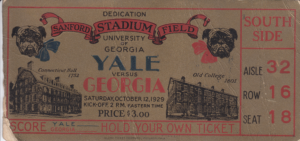“Poppa” and “Mimi”
Our grandfather Leon H. Grayson (1906-1993) was loving, generous, and affectionate. He was a big man, more than 6′ tall and somewhat stout. We called him “Poppa,” and when he wasn’t fixing us hearty breakfasts on Saturday mornings, he would bounce us on his knee, sing us silly songs, and growl at us like a bear. Our grandmother Mary Bell Grayson (1909-2001) was slender, dignified, a little vain, and had a sense of humor that was more wry than silly. We knew her as “Mimi” and she was affectionate too, though not nearly as demonstrative as her husband.
“…He played every day but Saturday.” -Mary Bell Grayson on her husband’s experience with the 1927 Georgia Bulldogs National Championship team

Leon H. Grayson 1928
Leon played football at Savannah (GA) High School, from where both he and Mary graduated. After receiving his Bachelor of Laws degree from the University of Georgia (UGA) in 1929, Leon returned to Savannah to set up private practice. Circumstances including the great depression soon led to Leon accepting a position in the Justice Department in Washington, D.C., where he and his new bride Mary lived for the rest of their long lives. They had only one child, but their daughter’s eight children were a constant presence in their two-bedroom apartment. The time we spent with Mimi and Poppa remains a treasure chest of warm memories. Among them is hearing Mimi tell us more than once in her soft southern lilt about Poppa’s involvement in football at UGA and being a part of “The Dreamin’ Wonders. He played every day but Saturday.” Saturday, she didn’t need to say, is game day. Okay, so Poppa wasn’t the star. Did he play at all? Was he the team manager or equipment man? Did he ever make a game-day appearance ala “Rudy”Ruettiger?
The University of Georgia and the 1927 “Dream and Wonders”
“When the University of Georgia was incorporated by an act of the General Assembly on January 27, 1785, Georgia became the first state to charter a state-supported university….In 1786, Abraham Baldwin, a native of Connecticut and a graduate of Yale University, was selected president of the university….John Milledge, later a governor of the state, purchased and gave to the board of trustees the chosen tract of 633 acres on the banks of the Oconee River in northeast Georgia.” –F.N. Boney, A Pictorial History of the University of Georgia, 1984 University of Georgia Press
In the 1870’s, a new sport called foot-ball, roughly based on the English sport that has become known as rugby, began to gain popularity in the northeast. Notable programs included those at Princeton, Columbia, Harvard, and Yale. What became the modern Southeastern Conference (SEC) began in the late 1890’s, when legendary coach Glenn “Pop” Warner was briefly a part of the fledgling UGA football program. After an alarming number of deaths resulting from in-game injuries, 62 schools gathered in 1906 to address changes to minimize those injuries, standardize the rules, and make the game more exciting. So began the NCAA and the modern era of American football.
The UGA football team was alternately called the “Red and Black” due to their color scheme and the “Bulldogs,” likely in honor of the Yale Bulldogs, the Alma Mater of their founder Abraham Baldwin. In 1927, when Leon was a sophomore Law student, the Bulldogs were coached by George “Kid” Woodruff, who in 1922 brought Knute Rockne‘s Notre Dame offensive scheme (along with one of Rockne’s legendary “Four Horsemen” in assistant coach Jim Crowley) to his native state. The team was led by All-Americans Tom Nash, later an all-pro with the Green Bay Packers and Ivey “Chick” Shiver, who went on to play Major League Baseball. The football team played its home games at Sanford Field in Athens, named for Steadman V. Sanford, a faculty member and major force behind the athletic programs at the college. Dr. Sanford served as future dean, president, and chancellor at UGA.

Georgia Defeats Virginia 32-0 at Sanford Field to open the season on October 1, 1927 (1928 Pandora Yearbook)
Sanford Field was a multi-purpose playing field dating to 1911 with wooden stands and limited seating. Despite their humble home field, the 1927 Bulldogs squad became known as the “Dream and Wonder Team” and far exceeded pre-season expectations. As the 1928 UGA Pandora yearbook put it, “In 1927 for the first time a Southern eleven won the unanimous recognition of the American football world… [until then] the cynical East remained unturned. Early in the season, on the sod of Yale’s historic Bowl, one of the mightiest elevens that the East had raised up in a decade was beaten down 14-10….Week after week opponents fell before Georgia’s splendid attack. ” The defeat of the Yale Bulldogs, alternately known as the Elis, was the first time UGA had ever beaten an Eastern power school. The team went on to put together six shutouts and allowed only three touchdowns in jumping out to a 9-0 record.
The East and the nation took notice. Only the Georgia Tech “Golden Tornado” remained between the #1 nationally ranked “Dream and Wonders” and a trip to the Rose Bowl. From the Pandora, “The bright victories of October and November have been far too much obscured by the fatal December affair…. It is useless to gainsay the extent of its damage…. [No] other thing can be said than that it was catastrophic.” In the season’s final game, following a heavy rain the night before – and accusations that Georgia Tech purposely continued to douse the playing surface of Grant Field, their ca. 1913 concrete stadium that could accommodate more than 30,000 fans – the sloppy and muddy pitch put the brakes on the prolific Bulldog attack. The season ended in bitter disappointment with a 12-0 loss to their in-state rivals. Even so, Georgia was retroactively named National Champion with a record of 9-1, though Big Ten power Illinois (7-0-1) received some shared recognition as did Yale, who shook off the loss to UGA and finished 7-1. Georgia Tech, who spoiled the “Dreams” of those 1927 UGA “Wonders,” went on to win the 1928 National Championship by going 10-0, including drubbing the Bulldogs 20-6 in front of 40,000 at Grant Field to earn their own trip to the Rose Bowl.
Leon Grayson and the Dream and Wonders
So what part did Leon Grayson play on this historic team? Was he a substitute? A practice player? An equipment manager? For many years, we believed he was a bench player. Research into a  number of sources gave no indication that our Poppa had anything to do with the team. In retrospect, I thought we must have missed Mimi’s mischievous wink when she said Poppa played “every day but Saturday.” Perhaps it was their inside joke, and the truth was in the various sources that were silent about him. Until…
number of sources gave no indication that our Poppa had anything to do with the team. In retrospect, I thought we must have missed Mimi’s mischievous wink when she said Poppa played “every day but Saturday.” Perhaps it was their inside joke, and the truth was in the various sources that were silent about him. Until…
In this newspaper clipping from the Savannah Morning News dateline Sept. 15, 1927 the columnist prophetically states, “The outlook for the team does not seem as bad as was thought at first.” We read in the subhead, “Weaver After Guard – Munn and Grayson Seeking Varsity Places.” We further read that “Grayson, a graduate of [Savannah] High is out for end.” In the official UGA team photo, forty-eight men are lined up in front of the stands at Sanford Field. Thirty of those men are named and given thumbnail photos including Savannah native “Buck” Weaver, playing guard as mentioned in the news clipping. Collins, Munn, and Grayson are not specifically named. In his Senior year biography, our grandfather Leon notes his involvement in debate, ROTC, numerous clubs, and the swimming team, through which he earns a “Minor” varsity letter. He does not list football among his activities. Nevertheless, his involvement with the team until at least the cusp of the Virginia game that began the juggernaut is clear. He practiced twice a day with and against these champions, not to mention frequent “skull practices,” and knew them each by name. Did he quit? Was he the last cut? Did he have regrets? Beyond the wry humor of his wife Mary, the subject didn’t otherwise come up.
Sanford Stadium
Successive losses to Georgia Tech in Atlanta in 1927 and 1928 convinced the University of Georgia to build their own concrete football facility in Athens, opened in time for the 1929 season. UGA football teams continue to play “between the hedges” at Sanford Stadium, which now seats more than 90,000 fans. Georgia’s unofficial sister school in New Haven, Connecticut, the elder Bulldogs of Yale University, had a tradition of playing every game but one at their own home field, the Yale Bowl – the sole exception being the annual rivalry long known simply as “The Game” versus the Harvard eleven. When UGA asked if the Elis would consider making the trip South to dedicate the new stadium, they graciously agreed. The ceremony noted the close kinship between the two schools, as UGA’s founder Abraham Baldwin, its first president Joseph Meigs, and most of its early professors were Yale graduates, while its first building, Old Franklin Hall, was built based on a blueprint of Yale’s Connecticut Hall. Leon attended the Yale-Georgia game and kept the souvenir ticket.  He was there in the heat of September 1927, striving to make the team that would win a national championship. He was there two years later to dedicate the stadium in which future champions played. Georgia defeated Yale that day 15-0. When Georgia Tech came to Sanford Stadium in December that year, the Red and Black shut out their hated rival 13-0.
He was there in the heat of September 1927, striving to make the team that would win a national championship. He was there two years later to dedicate the stadium in which future champions played. Georgia defeated Yale that day 15-0. When Georgia Tech came to Sanford Stadium in December that year, the Red and Black shut out their hated rival 13-0.
The Georgia Bulldogs have won 14 conference championships and at least a share of five national titles: 1927, 1942, 1946, 1968, and 1980. To this day come football season Leon’s grandchildren, including one proud UGA grad and her alum husband, still cheer them on. “GOOOO Dawgs! Sic ‘Em!”





No Comments